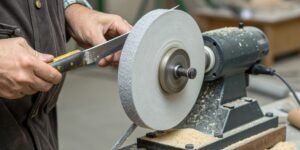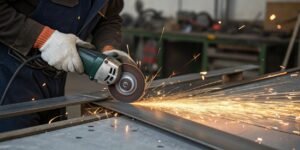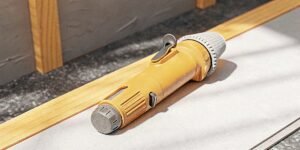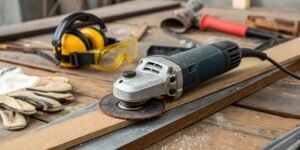
Can you use an angle grinder without a guard?
Having trouble getting into a tight spot? The guard on your angle grinder can feel like it’s in the way. But removing it is a risk you should never take.
No, you must never use an angle grinder without its safety guard. The guard is a critical safety feature designed to protect you from flying debris and catastrophic disc failure. Using a grinder without it is extremely dangerous.

It’s a question we hear more often than we’d like, especially from operators trying to speed up a job. As a manufacturer with nearly 30 years of experience, we’ve seen the devastating consequences of prioritizing convenience over safety. Every safety feature on a tool, especially a guard, exists for a reason—often a reason written from a past accident. We feel it’s our responsibility to be clear about the dangers.
Let’s break down exactly why this simple piece of metal is so important and answer the common questions we get about grinder guards.
Is it okay to use an angle grinder without a guard?
In a rush to finish a job? Tempted to remove the guard for convenience? This decision could lead to a serious, life-altering injury. Don’t take the chance.
It is never okay to use an angle grinder without its guard. This practice is incredibly dangerous and violates safety regulations in most workplaces. The guard is your main defense against wheel explosions and flying sparks.

In our decades of producing abrasive tools here in Henan, we’ve learned that safety rules are not suggestions. They are lessons learned from real-world accidents. The main danger isn’t just sparks or small bits of metal. The real danger is catastrophic disc failure1. A grinding disc spins at thousands of RPM. If it breaks, pieces fly off like bullets. The guard is designed to contain these fragments and direct them away from you. Removing it is like removing the armor from a tank because it’s too heavy.
The Real-World Risks
An unguarded grinder exposes you to several immediate dangers. The most severe is a disc explosion. This can happen if the disc is dropped, used at the wrong angle, or if it’s simply a defective product. Without a guard, the shrapnel has a direct path to your face, neck, and torso. We’ve heard stories from the industry of injuries that required hundreds of stitches and caused permanent damage.
Workplace and Legal Issues
Beyond the physical danger, there are professional consequences. In most countries, using a grinder without a guard is a direct violation of workplace safety laws, like those set by OSHA2 in the United States. If an accident happens, the company and the individual operator can be held legally responsible. This can lead to heavy fines, legal action, and a damaged reputation for your business.
| Risk Factor | With Guard | Without Guard |
|---|---|---|
| Disc Failure | Fragments are contained or deflected. | Shrapnel flies directly at the operator. |
| Debris/Sparks | Directed away from the user. | Uncontrolled, can ignite flammable materials. |
| Kickback | Guard can prevent the wheel from binding. | Higher risk of the tool kicking back violently. |
| Legal Compliance | Compliant with safety regulations. | Violation of OSHA and other standards. |
Can you take the guard off an angle grinder?
The guard seems easy to remove, just a few screws away from getting that perfect cut. But what are the real consequences of that simple action?
Physically, yes, you can take the guard off most angle grinders. However, just because you can does not mean you should. Removing the guard is a direct violation of the tool’s intended use and puts you at extreme risk.

As a manufacturer, we design our tools as complete systems. The motor, the handle, the abrasive wheel, and the guard are all meant to work together to be both effective and safe. When you receive a tool from us, whether it’s our RL brand or an OEM product we’ve made for your company, it has passed rigorous safety checks. Removing a key safety component like the guard instantly undoes all of that work.
The Manufacturer’s Perspective
From our point of view, the guard is not an accessory; it’s a non-negotiable part of the tool. Taking it off almost always voids the manufacturer’s warranty3. If the tool fails or causes an injury after you’ve modified it, the manufacturer is no longer liable. This is a critical point for purchasing managers and technical directors. You are taking on all the liability for your company by allowing unsafe practices.
How Guards are Designed
Most guards are attached with a clamp and a few screws. They are designed to be adjustable, not removable for operation. Some modern grinders are even being built with non-removable guards to prevent tampering. At our factory, we ensure that the guards we supply meet international standards for strength and coverage. We design them to withstand the force of a shattered disc, something we test for. When an operator removes that part, they are betting their safety on the disc never, ever failing. That is a bad bet to make.
Are guards required on grinders?
Wondering if that guard is just a recommendation? Or is it a hard rule? Not knowing the answer can have serious legal and physical consequences for you and your company.
Yes, guards are required on nearly all portable angle grinders by safety authorities worldwide, including OSHA in the United States. It is a mandatory safety device for most applications, not an optional accessory.

Safety regulations are not written to make your job harder. They are written to keep you alive. Over our nearly 30 years in the industry, we have seen safety standards4 become more strict, and for good reason. Every rule is a response to an accident that could have been prevented. As a B2B supplier expanding globally, we pay close attention to these rules. We make sure our products, like our diamond wheels and cutting discs, are safe when used correctly with all safety equipment5 in place.
Understanding Safety Regulations
Organizations like the Occupational Safety and Health Administration (OSHA) in the U.S. have specific rules. For example, OSHA standard 1926.303(c)(3) states that cup wheels must be protected by a special "revolving cup guard." Standard 1910.243(c)(1) mandates guards on portable abrasive wheels to protect the operator from flying fragments. Similar rules exist in Europe, Canada, Australia, and across Asia. These are not suggestions. They are the law for professional work environments.
| Authority | Stance on Grinder Guards | Consequence of Non-Compliance |
|---|---|---|
| OSHA (USA) | Mandatory for most applications. | Fines, stop-work orders, legal liability. |
| HSE (UK) | Mandatory under PUWER regulations. | Fines, imprisonment in severe cases. |
| EU Directives | Mandatory for CE marking compliance. | Product recalls, sales bans, legal action. |
Allowing operators to remove guards not only endangers them but also exposes your entire company to massive legal and financial risk. A safety inspector can shut down a job site for a single violation. For a purchasing manager, ensuring compliance is just as important as securing a good price.
What is the purpose of a guard on an angle grinder?
Does the guard just block your view and get in the way? You might think it’s just for sparks, but its primary purpose is something much more critical.
The primary purpose of a guard is to contain the fragments of a grinding or cutting disc if it shatters during operation. Its secondary purposes are to deflect sparks and debris away from you and prevent accidental contact.

Many people misunderstand the guard’s job. They see it as a simple spark shield. While it does help control sparks, that’s not its most important function. The real job of the guard is to save you from a catastrophic failure. An 115mm (4.5-inch) disc on an angle grinder can spin at over 11,000 RPM. If it breaks at that speed, the pieces have enough energy to cause fatal injuries. We produce millions of discs, from conventional corundum to superhard diamond products, and we build them to be tough. But no disc is indestructible.
Primary Purpose: Containing Explosions
Imagine a disc shattering. Instead of pieces flying at your face, neck, or arteries, they hit the inside of the thick steel guard. The guard absorbs the impact and directs the broken pieces down and away from your body. This is its most important job and the number one reason you should never remove it. It’s the difference between a startling noise and a trip to the emergency room.
Secondary Functions of the Guard
Besides containing a catastrophic failure, the guard has other important jobs:
- Spark and Debris Deflection: It directs the stream of hot sparks and abrasive material away from your body, reducing the risk of burns and preventing sparks from igniting flammable materials in the work area.
- Preventing Accidental Contact: The guard acts as a physical barrier. It can stop the spinning wheel from touching your leg or hand if you slip. It also helps prevent the tool from "walking" or kicking back if the wheel binds in the material you are cutting.
The guard is a multi-function safety system, not just a simple shield. It’s the most important piece of safety equipment on the tool itself.
Conclusion
Using an angle grinder without a guard is never worth the risk. Prioritize your safety by always using the guard and choosing high-quality, reliable tools for every single job.
-
Explore the causes of disc failure to better understand the risks involved. ↩
-
Find out OSHA’s guidelines on angle grinder safety to protect yourself and your business. ↩
-
Learn about the implications of modifying tools on warranty coverage. ↩
-
Stay updated on the latest safety standards to ensure compliance and safety. ↩
-
Discover essential safety equipment to use alongside angle grinders for maximum protection. ↩
Written by
leeon
You may also be interested in:

How to use a hard felt bench grinding wheel on knives?
Getting a razor-sharp, polished edge on a knife can be frustrating and slow. A dull knife is dangerous, and using the wrong tool can easily

What does an angle grinder do that other tools can't?
Struggling with tools for multiple tasks? Carrying a heavy toolbox is inefficient. An angle grinder replaces many tools, saving you time and effort on the

Which material is used in making cutting wheel?
Have you ever used a cutting wheel that wore out too fast or just wouldn’t cut? The right material is key to solving this problem

What is the smallest angle grinder?
Finding a grinder for tight spaces is tough. The wrong tool damages your work. Let us guide you to the perfect compact angle grinder for

Can you cut a pipe with a grinder?
Struggling to cut a pipe quickly and cleanly? Using the wrong tool can be slow, messy, and dangerous. An angle grinder is a powerful option

When should you use an angle grinder?
Feeling unsure about which tool to grab? Using the wrong one can waste materials and time. An angle grinder is a powerful, versatile solution for
